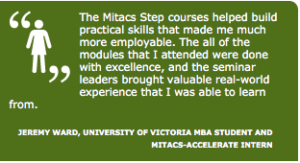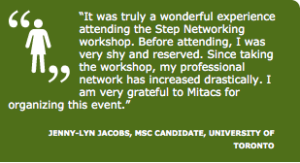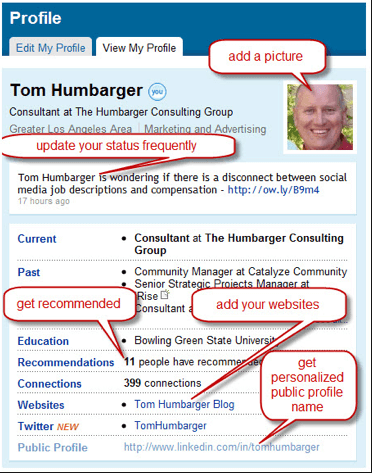Outstanding Professional Skills Training for Graduate Students & Post-Doctoral Fellows

 Post-graduate studies can provide an in-depth knowledge and expertise in a particular field. In any field, however, there is one common set of skills necessary for success: professional skills. Yet in many academic programs, there are few opportunities to refine these skills or enhance students’ abilities outside of the program requirements.
Post-graduate studies can provide an in-depth knowledge and expertise in a particular field. In any field, however, there is one common set of skills necessary for success: professional skills. Yet in many academic programs, there are few opportunities to refine these skills or enhance students’ abilities outside of the program requirements.
This is where the Mitacs Step program makes a difference. Mitacs Step provides professional skills development workshops for graduate students and post-doctoral fellows across Canada. The free workshops offered by Mitacs Step give students a competitive advantage as they launch their careers and enhance skills that will be necessary for a lifetime. Here at Corporate Class Inc., we excited to be part of this exceptional and accessible programming with our Business Etiquette and Networking Skills workshops in Ontario and the Atlantic provinces.
How Mitacs Step Lends a Competitive Advantage
The Mitacs Step program aims to build competencies for graduate and post-graduate students in four key areas that are recognized as essential for professional success. All of the Mitacs Step workshops address at least one of the following competencies; some address all four:
- Leadership & Management
From “big picture” management issues (such as influencing future outcomes, risks and impacts) to day-to-day organizational processes (such as planning, budgeting and performance management), participants learn skills necessary to lead and manage people and projects. - Communication & Relationship Building
Working with people – and doing it well – is essential to success. Mitacs Step helps participants assess situations and communicate solutions, while fostering collaborative environments and offering constructive feedback to a team.
- Personal & Professional Management
For individual success, Mitacs Step aims to help students find self-management techniques to achieve their career and personal goals. - Entrepreneurialism
Participants are encouraged to identify professional surroundings as a professional marketplace – then acquire the tools to take advantage of opportunities within that marketplace.
To address these four competencies, Mitacs Step offers a range of workshops that are hands-on and interactive and help students apply these skills to both academic and non-academic settings. Further, the workshops provide access to networking opportunities and industry expertise.
Corporate Class Inc. in the Mitacs Step Program
We are excited to be part of the Mitacs Step programming. With sessions on both Business Etiquette and Networking Skills, our team connects with graduate students and post-doctoral fellows in universities across Ontario and the Atlantic provinces.
- Business Etiquette: This full-day workshop aims to increase awareness of how one’s actions and behaviours matter in building personal and professional relationships and reputation. The session begins with an overview on business etiquette. It then discusses the role of business etiquette in and out of the workplace environment, using technology appropriately, running and participating in effective meetings, and personal appearance.Click here to learn more about the learning objectives and key topic areas covered during the workshop.
- Networking Skills: In the full-day Networking Skills session, participants gain insight on how to build and sustain professional relationships through effective networking. Participants then have the opportunity to try out the skills learned during the workshop during an in-session networking opportunity.
Click here to learn more about the learning objectives and key topic areas covered during the workshop.
We look forward to meeting you at one of the upcoming Mitacs Step workshops. For extraordinary skill development for emerging Canadian professionals, find a workshop here or share this link with a graduate student or post-doctoral fellow today!
“Spring Cleaning” for Your LinkedIn Profile
Networking Events Actually Worth Your Time
Millennials: Jump-Start Your Career
Millennials: Have you recently finished your studies, are preparing to graduate, or are just starting out in the first few years of your career? Does the sheer number of like-minded peers entering the workplace at once overwhelm you, and are you uncertain on how you can set yourself apart from others?
Do not fear: developing your business etiquette skills and enhancing your Executive Presence can make a remarkable difference as you define yourself in the workplace and launch your career with a strong start. These skills generally are not taught in universities, nor are they intuitive when you enter the workplace. Refining them at the start of your career can make a lasting impact on your future.
Standing Out from Others
- At the start of a career, many individuals have little or no previous professional experience. But even if you do not have many qualifications and experiences on your resume, you can still appear professional and competent – without seeming too self-assured or overconfident. Business etiquette skills can help you achieve this, as well as help you to set yourself apart from others entering the workforce.
- Except for certain commerce programs or career workshops, there are not many opportunities to learn business etiquette in universities or colleges. Yet as you enter the professional world, it is essential to have an understanding of the skills that are outside of the technical qualifications of a job: such as business dining etiquette, how to appropriately use technology in the workplace, or the benefits of a good headshot. As the chances for Millennials to learn these qualities are simply too few and far between, you will have a significant advantage if you do take the time to learn and develop your business etiquette know-how.
Setting the Stage for Success in the First Years of Your Career
- The first few years of your career are absolutely essential in setting yourself up for a lifetime of success. At this point, you already need to be building professional relationships, asserting your ideas, and making great first impressions. Do not wait until you are older to start these important steps.
- It is proven that your twenties are a critical period of development. In an insightful and eye-opening Ted Talk titled “Why 30 is not the new 20,” clinical psychologist Meg Jay discusses the need stop delaying adulthood and for young adults to be accountable for their decisions and development at an earlier age. According to Dr. Jay, “the first ten years of a career has an exponential impact on how much money you’re going to earn.” This statement is not to be taken lightly. If you start off on the right foot, you will thank yourself later.
Resources to Help You Start
- If you are unsure of where to start, look no further than this blog. In addition to the links provided above, we offer practical posts on good behaviour in the workplace, great techniques for confident networking, and tips for business dress. Understanding the value of these attributes and how to apply them will help to guide your own career.
- In addition to Dr. Jay’s fascinating Ted Talk, her book The Defining Decade: Why Your Twenties Matter – and How to Make the Most of Them Now shares useful advice and important statistics. See also Ashley Crouch’s 8 Tips for Millennials to Make 2014 Their Best Year Yet, or Dan Schwabel’s 10 Best Pieces of Career Advice for Millennials.
Your twenties are an exciting part of your life and career. Make the most of this decade by making thoughtful decisions, fostering meaningful connections, and developing your skills!
Why Employee Retention Matters – and How to Achieve It
 For any company, employee retention is important for clear reasons: when an organization retains its employees, it means the staff is dedicated and satisfied; additionally, the employees’ years of experience contribute to a well-informed and efficient staff. If you are a leader within a company, you inevitably contribute to employee retention and need to plan to retain employees who are high performing.
For any company, employee retention is important for clear reasons: when an organization retains its employees, it means the staff is dedicated and satisfied; additionally, the employees’ years of experience contribute to a well-informed and efficient staff. If you are a leader within a company, you inevitably contribute to employee retention and need to plan to retain employees who are high performing.
What are some tactics to achieve employee retention in your company?
Cultivate employee growth and development
- On an annual basis, it is a good idea for an organization to require all employees to define their goals and objectives for the year ahead. Take this opportunity to allow employees not only to map their upcoming year, but also to envision a path of growth and advancement several years down the line. This will encourage employees to think long-term at your company, and will send a message to them that they are valued in the company’s extended plan as well.
- Provide opportunities to employees to grow and develop as professionals generally. This could include dedicated training sessions or programs for business etiquette, or a weekly or monthly Lunch & Learn session on a range of topics. Employees will welcome an opportunity to learn alongside their daily work, and their skillsets will expand because of it.
Focus on staff morale
- Keeping employees happy and satisfied in their work is crucial to retaining good staff. In an earlier blog post, Boosting and Maintaining Employee Morale, we discuss three ways to promote employee morale in the workplace: create a culture of communication, foster friendliness among coworkers, and acknowledge accomplishments. For concrete examples and more on this topic, click the link above to read the post.
Encourage challenges – and reward employees accordingly
- A high-performing staff will thrive on professional challenges and great goals. The first step, then, is to hire high-calibre employees. Hiring is not a process to be approached lightly; finding excellent employees who will fit well in a company means multiple resume reviewers, seeking employees with an impressive work history or credentials, and at least two rounds of interviews for top candidates.
- Once your staff is comprised of those who are willing to accept challenges, use high goals to enable them to thrive: inspire them to bring their own ideas to the table to advance a project or reach a milestone, and expect results from their work – requiring that they measure, document, and present their success.
- In all their demonstrations of excellence, ensure that employees are acknowledged accordingly with due credit, both informally through verbal or written praise and formally through honours or salary increases at appropriate opportunities.
Warning: though employees should be challenged and often will find success within such tasks, do not overwork your employees. If staff members feel pressured to work beyond their capacity on a regular basis to meet goals, this will have the opposite effect on your retention strategy. To prevent employees from burning out, encourage maintaining a work-life balance and opportunities for wellness, both in and out of the workplace.
How To Facilitate Effective Meetings
As a leader in your company, you will encounter various roles and responsibilities that will allow you to demonstrate your leadership. One example is in facilitating effective meetings. In a productive meeting, the organizer communicates their ideas while incorporating the valuable contributions from other participants, while simultaneously managing time and direction of the meeting to ensure efficiency. In doing so, the meeting facilitator demonstrates the ability to guide and contribute to the overall strategy of the organization.
Below are several tips on facilitating the most effective – and efficient – meetings.
Prepare in advance
It may seem obvious, but the universal motto to “be prepared” applies for several different components of a great meeting:
- Write the itinerary ahead of time and email it to meeting participants. Seeing the schedule on paper and running through the length of the meeting in advance will help you to gauge whether the meeting time will run long and if you need to cut out any items from the itinerary.
Also, emailing the itinerary to participants will allow them to know what to expect. This will let them ruminate over discussion points in advance and likely better ensure the meeting stays on track.
- Circulate any pre-reading at least two days in advance, if possible. Background reading, if relevant, is an excellent addition to a meeting in that it will facilitate a more robust and informed discussion. Just make sure you give participants enough time to review the materials.
- Avoid technical difficulties during meeting time by testing any technical components – presentations, teleconference lines or otherwise – in advance.
During the meeting
During the meeting, a few tactics can help you to address the main points of discussion clearly and concisely:
- Use materials to illustrate key concepts. Presentations, handouts, binders or other materials that lay out ideas visually for participants will help them to follow along and internalize the messages.
- Incorporate discussion throughout the meeting. The primary difference between a meeting and a presentation is that the role of the meeting participant is essential in the outcome of meeting – so let their opinions play a part! To capture the points of discussion, ensure someone is designated to take notes during the meeting.
Follow up
The process is not over when a meeting concludes. Take the appropriate follow-up steps to ensure the effectiveness of your meeting:
- By the end of the meeting, determine a list of action items and who is assigned to complete each task. Also, decide what will be addressed at the next meeting. Shortly after the meeting concludes, email these items to attendees while they are still present in your mind.
Running an effective meeting includes more than simply keeping the conversation on topic. A valuable meeting can influence the overall strategy of your organization – and show your leadership skills in doing so.
Give Your Best Job Interview: Prepare in Advance
With a job interview looming on the horizon, most of us would feel a little (or a lot) nervous as the big day approaches. The best way to conquer your anxiety is to be as prepared in advance as possible – so there are no surprises on interview day and you can focus your energy and attention on making a great first impression.
I encourage you to watch the video above. In this clip, social psychologist Amy Cuddy shows how “power posing” — standing in a posture of confidence, even when we don’t feel confident — can affect testosterone and cortisol levels in the brain, and might even have an impact on our chances for success. Amy Cuddy shares a great technique to use just before a job interview.
Here are a few ways to prepare in advance for a job interview, so that you can look and feel your professional best on interview day.
Choose your outfit days ahead of schedule
Nothing builds stress like tearing through your wardrobe for professional attire on the morning of an interview, only to find that nothing looks or fits properly. Instead, choose your outfit in advance – leaving at least a few days in case a suit or jacket needs to be dry-cleaned, tailored or mended.
Spend time carefully weighing your choices, making sure that you land on an outfit that is very professional and properly matching, leaving additional time to consider accessories. Ask for a second opinion from a friend or family member to make sure the outfit works – and to look it over for any stains or tears you may have missed.
Buy thank-you cards
Writing a thank-you card to every member of the interview team is an essential way to finish off an interview. In advance, find a set of professional yet elegant business thank-you cards and a fine pen.
Go the extra mile and pack a few thank-you cards in your portfolio or briefcase before you leave for the interview, so you can write and send them immediately afterward to ensure the cards arrive in the mail as soon as possible.
Know the interview location – and how much time it takes to get there
Simply knowing an address does not mean that you know exactly where the interview will take place. Find out precisely where you need to go: for example, if the office has a suite number not listed on the address, or if you will need to sign in at a security desk before getting to your destination.
In addition, research how much time it will take to get there, and if you have the opportunity, do a “practice run” from your house to the interview location. Take note of possible construction sites or delays due to traffic. On the day of the interview, try to budget even more time to account for unknown factors along the way. Being punctual to an interview is essential: if you are late, most likely you have already lost that job opportunity.
Brainstorm answers to sample questions
Think of several standard interview questions – you are almost always asked about your work history, experience, skills, strengths and weaknesses – and spend time brainstorming possible responses. There will be some unexpected questions during the interview, but likely you will be able to draw upon what you have thought of in advance. Also, spend time reviewing your resume or CV so that you can speak to it without hesitating.
Research, research, research
Spend a great deal of time researching the organization and the position you are applying for. If you know the ins and outs of an organization: its history, evolution, and latest developments and progress, the interview team will know that you are serious about the job and that you have invested time to prepare. This can set you apart from the group of applicants.
You may not be able to alleviate all of your anxieties before an interview; in fact, this may be a good thing, in that a bit of nervousness means that the job is important to you and additionally will keep you on point and alert throughout the interview. However, with just a few steps in advance, you can let go of a few worries beforehand – allowing you to focus on presenting your best self during the interview.
If you’re not sure about choosing the right clothes and accessories or simply want to update your look to get the job you want consult with an expert image consultant today.
How to Get Involved in Your Professional Field
Last week we focused on three top ways to grow as a professional, one of which was to stay active in your field. This week we’ll give this topic even more attention, as there are many ways – and important reasons why – you should be connected and actively involved in your area of focus. If you extend your reach outside of your company to build your knowledge base and experience, it can benefit your company, your department, and yourself as a professional.
Consider joining a professional association
- Many professions have a national association or organization designed to support members working in a particular field. Benefits of membership can include continuing education or building credentials, access to career and job opportunities, subscriptions to relevant publications, and opportunities to meet other professionals in or outside of your local area.
- These associations often function on a national and provincial level; view a full list of Canadian professional associations courtesy of the Canadian Information Centre for International Credentials.
Attend national and international conferences
- There are few better ways to stay connected in your area of interest than by attending conferences, both locally and abroad. Leaders in your field present ideas and new developments, and conferences generally provide several excellent networking opportunities.
- The content discussed in conference keynotes, panels, and side meetings often indicate where the field is heading or what new developments may be on the horizon.
- You can gain unique and valuable information or skills at a conference, which you can then apply to your own work back in your company.
Participate in additional and less formal events
- In addition to conferences, there are other opportunities to participate in less formal discussions and events that are related to your field of work. Meetup.com is a site designed to connect locals with shared interests; though the selection of various Meetups includes hobbies and personal interests, it unites those with similar professional work and objectives as well. Meetups can include anything from a small group discussion to a panel event with notable speakers.
- Participate in an online forum. Instead of simply posting your resume and credentials on your LinkedIn profile and leaving it there, actively engage on LinkedIn by starting or joining a discussion group for like-minded professionals on a relevant topic. You may be surprised how extended and enriching a LinkedIn discussion can become: these discussion groups have no expiry date, so the conversation can continue to grow indefinitely as more members can join in.
Network – and maintain your connections
- The key to keeping a strong network is to maintain your connections. You may have hundreds of contacts, but if you do not foster those relationships, they will eventually lose their value. I always tell my clients “your network is your networth.”
- Simply maintaining connections now means that you may benefit from them in the future: a fellow professional may present an opportunity for collaboration or partnership; a contact may be able to assist you transition between companies or provide a career opportunity; another contact may become a client someday. You never know how or when your strong contacts will support you – but it is very likely that ultimately they will.
Find out more about our business networking with a twist lunch and learn workshop today and grow your network (and your net worth) quickly and effectively.
New Year’s Resolutions for the Workplace
 Happy New Year! How will you ring in 2013?
Happy New Year! How will you ring in 2013?
Many of us start off a fresh year by making a resolution or two, aiming to better ourselves through small changes to our habits. This year, consider making a professional New Year’s resolution – because even small improvements in your routine in the office or your business interactions can help you to advance your career or make your mark professionally.
Resolve to Make Connections
Are you a shy person who only talks to familiar colleagues at networking events – or just skips the event altogether? In 2013, resolve to break out of your shell by making new professional connections, both inside and outside of your company. Besides participating in networking events, take other steps to build your contact list: set lunch dates with potential partners or clients, or schedule informational interviews with business contacts. Creating and maintaining professional relationships is an important piece of advancing and growing in your field.
Resolve to Be a Leader
Displaying leadership in the workplace is a solid building block for moving up in your company. You can demonstrate leadership in tasks big and small: anything from taking the initiative to assist a new colleague, to planning and executing an important project. Consistently displaying leadership qualities will work to your advantage, especially as management begins to notice your initiative. Practicing leadership can also boost your confidence and comfort level in the workplace.
Resolve to Improve Your Presentation Skills
No matter how impressive the content of your work, your messages simply will not resonate with colleagues or clients if you cannot deliver them in a strong presentation. Giving great presentations is something that many professionals struggle with, whether it is due to stage fright, nervousness or just unfamiliarity with speaking in front of a large group. Awareness of the key elements of an effective presentation – body language, posture, articulation, well-planned slides and talking points, appearance and attire – plus lots of practice can help you to strengthen your presentation skills and effectively deliver your messages.
Resolve to Build Your Executive Presence
Executive Presence is not a single trait that can be acquired overnight; rather, it is a hybrid of characteristics, which are all critical for a successful professional to have. A recently published study by the Center for Talent Innovation defines the foundations of Executive Presence as gravitas, communication and appearance, and makes no question of the importance of Executive Presence, stating that it “accounts for 26 percent of what it takes to get the next promotion.” You can work on building your own Executive Presence through training programs, Lunch and Learn sessions, customized webinars and individual consultations that focus on skills such as communication, business etiquette, and professional image.
Even through small changes, we can all work toward becoming stronger and more successful professionals. What better time to improve your daily habits for lasting results than at the start of a brand new year!





